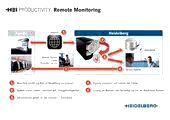Offset Printing
HEI Productivity: New service offering from Heidelberg ensures smooth press operation

Friday 17. May 2013 - Expanded generation of Remote Service identifies malfunctions before operations grind to a halt
Remote Monitoring means service call-outs can be planned in advance: Lower costs, increased productivity
Focus on industrial print shops with high availability
For most print shops, press downtime means lost money and dissatisfied customers. Previously in such cases, a service engineer generally had to resolve the problem on site and request spare parts if necessary. All in all, it was a pretty laborious process. Since the introduction of Remote Service technology around ten years ago, customers have been benefiting from significantly shorter reaction times and downtimes. Many malfunctions can be resolved directly online or over the phone. If it is necessary for a service engineer to visit, prior analysis enables him to order any spare parts required in advance. Heidelberger Druckmaschinen AG (Heidelberg) has continually optimized and expanded the functions of its Remote Service technology, which has received multiple awards. Since the introduction of Remote Diagnosis in 2004 and the eCall automatic alarm function derived from it in 2008, Heidelberg has enjoyed unique selling points in this field within the industry.
At China Print in Beijing from May 14 to 18, 2013, Heidelberg will be presenting the Remote Monitoring function, the next stage in the expansion of Remote Service technology and an option available to customers as part of their service contract. Thanks to the Remote Monitoring function, Heidelberg Systemservice can continually monitor presses fitted with Prinect Press Center via a secure Internet connection and identify any irregularities early on. If the system picks up on potential malfunctions, a Heidelberg expert evaluates the data and summarizes it in a list of tasks. This list is worked through during the next scheduled service callout. The aim is to minimize unplanned downtimes. By intelligently combining all the tasks to be done during a service callout, the necessary measures can be carried out during one single visit. In addition, Remote Monitoring users also receive detailed reports on the status and performance of their presses.
For customers who require ultra-high press availability and have to be able to rely on their production systems around the clock, Remote Monitoring is an attractive way to boost their competitiveness.
“To ensure we can meet our customers’ requirements by significantly reducing costs while also improving productivity, we are moving our entire service approach away from a more reactive malfunction process to increasingly active, planned callout management,” says Bernhard Steinel, head of the Systemservice business area at Heidelberg.
